Soham Grammarians : from the School History
CHAPTER XI: THE LAST CHAPTER Autumn 1939-1972
from the History
of Soham Grammar School (Browning, revised
Abbott 1972) which, together with the Soham
Grammarian magazine, unless otherwise specified
is the source of images. Visitors able to provide
photographs or illustrations to enhance this text
should please contact the editor.
The Autumn Term of 1939, which saw Europe
at war, saw Soham without a headmaster. It would be idle to
claim that the war left no mark upon the school. It hardly
needed the Dean of Ely (the Very Reverend L. E. Blackburne)
at Speech Day 1940 to exhort everyone to co-operate in the
struggle for victory for Soham had already taken up the task.
The summer holiday of 1939 had seen 18,000 sand bags used in
the construction of trenches. In the early days of the war
air-raid alerts seriously disrupted teaching as the school
had to be evacuated to the trenches. After numerous false
alarms a scheme of aircraft spotting was instituted making
interruptions largely unnecessary.
Other effects of the war were to be more
permanent. The unavailability of transport in war-time led to
the cancellation of inter-school matches, laying much greater
emphasis than usual on house Rugby. Hot lunches were provided
at Soham, as at most schools, since family life was
frequently disrupted by the need for women to fill jobs
vacated by men joining the Services: though few realised it,
school dinners had come to stay. While senior pupils became
involved in A.R.P. work, the well-being of servicemen was
kept in mind, witness a collection made at the Old Boys'
dinner and the school's participation in the local waste
paper collection.
Mr. Johnson's period as acting head
concluded on 1st January, 1940, when Mr.
Stanley Stubbs, M.A.,
arrived from Gresham's School, Holt, where he was Modern
Languages master, to take up his duties as Headmaster of
Soham Grammar School. He, too, encouraged the school in its
war efforts. Ministry of Information films were shown
regularly to strengthen morale, instruct or warn. Collections
continued to be taken for special efforts - the Spitfire Fund
(Christmas 1940) and War Weapons Week (May 1941) - but surely
the outstanding financial contribution came through regular
National Savings. Under the enthusiastic control of Mr. Hunt
these totalled £5,299 over 5½ years during which 428 pupils
passed through the school though the total at any one time
never rose above 236 (October 1944).
The proudest effort was the raising on 10th
February, 1941, of a squadron of the Air Training Corps,
Soham Grammar School Flight No. 773. It made its first public
appearance on 18th May at the beginning of War Weapons Week,
as A. H. Talbot described:
"Sunday's parade of
Military and Civil Defence personnel held special
significance
for the school as for the first time, the recently formed Air
Training Corps squadron
was on parade under Flying Officer S. Stubbs and Acting Pilot
Officer C. C. Copland.
An open-air service at which the address was given by a
Chaplain to the Forces,
was conducted by the Vicar (Revd. P. F. Boughey) on the
Recreation Ground, following
a physical training display and gun drill by local military
detachments".
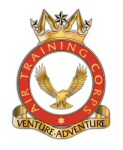 Mr. Crouch was
also an acting Pilot Officer and by the end of the
war over 200 cadets had passed through the unit. Mr. Crouch was
also an acting Pilot Officer and by the end of the
war over 200 cadets had passed through the unit.
More than 100 joined the armed services - mostly the
R.A.F. One hundred
certificates of proficiency were gained and 15
members passed advanced training examinations. The
efficiency of the corps had been increased from the
Spring of 1942 by the securing of a Hawker Hector
army co-operation aircraft. It really flew, it had a
range of 400 miles, a cruising speed of 162 m.p.h.
and every member of the squadron had a flight.
[Actually it did not fly. However members of the ATC
did often have the opportunity to gain experience of
flying when visiting RAF units - see 773
Sqn (SGS) ATC.]
|
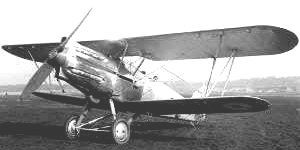
A Hawker Hector: This was a British Army
co-operation warplane in service from 1937 to the
late 1940s. Powered by a Napier Dagger IIIMS H-type
piston engine rated at 805hp providing a top speed of
187 mph and an endurance of 2h 25min. Crew: pilot and
observer/gunner seated in tandem in open cockpits.
Armaments: 1 x 0.303 inch Vickers MkV fixed
forward-firing machine gun in the port side of the
forward fuselage firing through the propeller disc,
and 1 x 0.303 inch Lewis trainable rearward firing
machine gun in the rear cockpit. Up to 250lb of
disposable stores could be carried on two underwing
hardpoints. Superseded by Westland Lysander.
source : Probert Air
Encyclopedia |
Although numerous bombs were dropped in
Soham parish during the war, the school suffered no physical
damage until 2nd June, 1944, when the explosion of two trucks
of an ammunition train caused blast damage. Only the valour
of the train crew saved Soham from numerous casualties. As it
was this constituted a "major incident". During
rescue operations the school served both as an administrative
H.Q. and as an A.R.P. Rest Centre, a task for which it had
been prepared. Further slight damage was caused by a V.1
exploding nearby in September 1944 and when an American
Flying Fortress crashed in the fields behind the school after
a mid-air collision in February 1945.
The war also affected the school's more
proper, educational function. Two members of the staff left
for war work: Mr. Lait, a mathematician, to the Ministry of
Supply; Mr. T. L. Riley to help guide the army through
Europe. Losses of staff were difficult to make good. In the
Spring of 1942 the school was fortunate to be able to call on
the services of the curate of Soham, Rev. T. V. Hurdle, to
teach mathematics and physics. He was to continue at Soham
for over three years and as Mr. Stubbs commented, "we
are very fortunate in securing a master so able and
well-qualified, and I am grateful to all concerned in making
the appointment possible". Further gaps in the staff
were regularly filled by women, some seven having taught at
Soham by the end of 1945. So was set a precedent that was
to revive in the late sixties.
Despite the upheavals Mr. Stubbs managed to
ensure that the educational standards at Soham did not
deteriorate. In this first year the whole of the former
private and boarding parts of the building were taken over to
provide necessary rooms for the larger number of boys. These
additions included new form rooms, an extra Science room, an
Art room, extended workshops, a new Staff Room, storage rooms
and, most badly needed of all, a Library. With better
physical provisions more was likely to be achieved
educationally. This was seen to be true in 1942 when three
boys took the Higher School Certificate and thirty boys the
Lower: the results were received with joy, for all
thirty-three were successful. An academic pattern had been
established that was to be fostered for the remaining thirty
years of the school's existence.
But Mr. Stubbs was not content to encourage
mere bookishness. In the Autumn of 1941 with the aid of Mr.
Crouch and Mr. Johnson, he established a house drama
competition which was to exist till 1952 and which provided
the basis for the school's undoubted dramatic reputation
during its last two decades. This house competition was fully
in line with the headmaster's general policy, for a year
earlier he had reorganised the house system. As will be
remembered, inter-school competition had ceased on the
outbreak of war and strong house competition was encouraged
as a replacement.
Thus it was that the houses were aligned:
Soham boys made up Ridley House (Bishop Ridley having once
been Vicar of Soham), other Cambridgeshire boys entered
Chicheley (named after the Lord of the Manor of Soham at the
time of the school's inception); while Isle of Ely pupils
were divided between their local heroes, Hereward and
Cromwell. This arrangement lasted for 3 or 4 years only.
Other innovations too were aimed at
improving sporting standards. Extra cups were provided for
the Under 14 100 yards and for the Junior Mile to encourage
the best athletes. To allow those of lesser attributes to
make a contribution, sports standards were introduced,
counting in the house championship from 1942. The summer of
1944 saw two matters of moment: different games afternoons
were allocated to Seniors and Juniors. Either because of or
despite this change, the Junior Shield of the Fenland Athletics championships was won for
the very first time.
Intellectual pursuits were also thriving as
the school Chess Club, founded in 1942, won its way to the
final of the British Chess Correspondence Association
Inter-schools tourney in 1943 only to be defeated by
Worcester Royal Grammar School. Music too was brought to the
southern fens. Autumn 1940 saw Albert Sammons (violin) and
Gerald Moore (piano) performing in the school, while in 1942,
such a conspicuous year in the school's war-time story,
Benjamin Britten and Peter Peers provided the highlight of
the season.
So the war drew to a close. It was to mark
the end of a distinct era for the Education Act of 1944 had
brought statutory changes, the most important of which was
the end of fee-paying in Grammar Schools. With it came the
infamous eleven plus. This was to herald both the greatest
days of Soham Grammar School and its demise. Throughout the
war the school had been expanding which led eventually to
permission for the building of three new classrooms, a dining
hall and kitchens in a single block to the west of the lawns.
In anticipation of this the school was
reorganised in 1944 on a two form basis to avoid the classes
of forty which had begun to appear. Almost inevitably delays
ensued and before the work was completed another change
overtook Soham. In 1945 Mr. Stubbs resigned upon his
appointment as Headmaster of the Perse School. So it was that
a new hand guided the school's final quarter century as it
became a traditional, academic grammar school, the hand of Mr.
E. Armitage, M.A., B.Sc.,
formerly Physics master at Bradfield College.
The new headmaster inherited sound
intellectual traditions, albeit restricted for six years by
war-time stringency. For instance, shortly after his arrival
there occurred another such musical occasion as had lightened
the war when, this time under the auspices of the Soham
Musical Society, Kathleen Ferrier and Isobel Baillie
performed at the school. And if Mr. Crouch followed Mr.
Stubbs to the Perse, Mr. Riley soon returned from his
military service, strengthening the ties with pre-war years.
The previously planned and long-awaited extension came into
use in February 1946.
This improvement to the facilities
encouraged the school to seek new avenues to explore for Mr.
Armitage would not be content to rest on past laurels. In the
magazine at the end of his first term he wrote:
"Let us strive to
preserve and even improve our record of high academic
attainment ...
Further let us realise there is more to school life than
passing examinations, important as these
are. Learning how to live is, in the long run, more important
than either French or Physics.
To know how to use one's leisure, to have good manners and to
be able to speak correctly
... All these it is the business of a school to teach and
equally the duty of every boy to learn."
The pursuit of these ideals for 27 years
was to make his contribution probably the most significant in
the school's story. One of the new headmaster's first actions
was to arrange for the resumption of boarding in 1946 when
eight pupils took up weekly residence at The Moat. Another
change of that year was to hold Speech Day in a local cinema.
With parents and boys united for the ceremony as they would
never be in the old Assembly Hall, a greater corporate spirit
could be fostered though the experiment came to an abrupt end
the following year when the severe winter and concomitant
fuel rationing ruled out the use of this building.
However the same spirit led by the end of
1947 to the forging of more permanent links between school,
staff and parents. With the formation of the Parents'
Association, whose inaugural meeting was held in December, a
vehicle was provided for the discussion of problems on a
regular and personal basis. In the following September the
curriculum of the 4th and 5th forms was reorganised to take
account of the different aptitudes and abilities of the wider
intake. As a result 13 out of 19 candidates from the new B
stream passed the School Certificate. In the following year
therefore a new division of the Sixth Form the Technical
Sixth - was formed to cater for boys seeking a theoretical
background in more practical subjects.
Further building had taken place so in
September 1948 a new Physics laboratory was in operation and
the same academic year saw, in the summer, the first of
several acts of faith when the Speech Day ceremony took place
on the lawn. Later in 1949 came the first regular intake from
the borough of Cambridge - 5 to be exact - as the population
increase began to make itself felt on local schools.
But of all the changes of those early
post-war years the most noticeable was the introduction of
soccer for rugby as the winter game. It was for this reason
that Mr. R. A. Taylor, M.A., a triple Cambridge blue, joined
the staff from Watford Grammar School. Coming first in 1946
he took a brief sojourn in Canada before beginning his more
permanent stay in 1948. The school playing-fields had been
extended not for the last time - to provide more pitches
and during the following years sport was to prosper at Soham
as never before. In the first five years of a real soccer
programme from 1947, of 66 matches played 45 were won and 7
lost. Though 1952 was a lean year with only 6 victories from
14 games, the following 12 years to 1964 produced a record in
school games of 143 wins, 15 draws and 17 defeats.
Cricket was also to prosper, though the
English climate makes it extremely unlikely for comparable
figures to be attained. Athletics did not come into its own
till the early 1960s when the appointment of a further P.E.
master allowed wider activities. After this shields were
frequently won in the Fenland athletics and cross-country
matches.
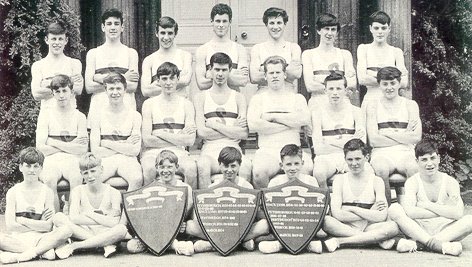
ATHLETICS TEAM FENLAND SCHOOLS SPORTS 1964
Winners of Middle, Senior
and Champion School Shields.
please click on image for a key
The most recent years have seen a great
diversification of sporting activity with more emphasis on
tennis, the introduction of basketball and badminton, golf,
fencing and canoeing. It is not surprising that Old Boys of a
school with this record have continued to meet with sporting
success. True the Old Boys' Rugby Club had to be reorganised
as Ely R.U.F.C. in 1951 - a predictable result in view of the
school's change to soccer - but there has been some notable
individual achievement. H. Kant represented Britain in the
400 metres hurdles in the Melbourne Olympics (1954) [actually
1956 - editor], a year which saw D. Bray win the first full
blue by an old boy (boxing for Cambridge) and Mr. Taylor
playing alongside two former pupils in the Cambridgeshire
Minor Counties cricket team. J. J. Fordham won a soccer blue
(for Oxford) both in 1958 and 1959.
The varied activities of old boys are far
too numerous to mention but recently two joined Voluntary
Service Overseas .. Eric Pearson in Labrador (1967-8); David
Smith in the Windward Isles (1968-9). The very last year of
the school a pupil, P. Leonard, has spent at an Illinois High
School, sponsored by the American Field Service.
The Old Boys' Club, reformed after the war
in 1947, has maintained close links with the school despite
the increasing tendency of late for boys to move away from
the Fens for employment. It seems likely to continue to
function long after the school has ceased its separate
identity. Certainly the school remembered those former pupils
who were killed on active service at war. In 1951 the novel
War Memorial, in the form of wrought iron gates at the
entrance to the playing field, was erected. For twenty years
the Friday before Remembrance Sunday has witnessed a moving
ceremony of gratitude culminating in the planting of a field
of poppies.
| The purchase of these
Memorial Gates was the predecessor of three colossal
fund raising activities of self-help. The first in
1958 was the Cricket Pavilion Fund. Centred on a
Summer Fair, opened by the Mayor of Cambridge who
happened to be an Old Boy (R. D. W. Wordingham), the
effort raised £1,300. No sooner had the Pavilion
come into use than another project was launched in
1961. |
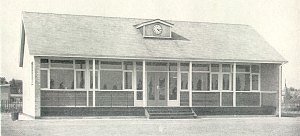
The Cricket Pavilion, opened 12th May 1961 |
This time for a swimming pool, £400 was
raised though the project was to be delayed by negotiations
over the building of a Soham town swimming pool. In 1964,
£1,268 was collected, again mainly from a Summer Fair, to
build the Scout Hut, to make purchases of musical instruments
and a sculpture and to contribute to the memorial fund for
Henry Morris, C.B.E., formerly Cambridgeshire's Chief
Education Officer, the originator of the county's Village
Colleges.
In 1968 when it became obvious at last that
Soham would not provide its own swimming pool, another fete
helped to raise £1,386 which with previous monies plus a
similar amount from Soham Village College and a county grant
enabled the swimming pool to be built. The raising of well
over £4,000 by a small rural grammar school in under 20
years speaks volumes for the co-operation of parents, pupils
and staff to provide amenities beyond the pocket or the
purpose of the County Council.
Yet much expansion had been provided by the
local authority over these years. By 1954 the school had
increased by well over 100 pupils since the last major
building extension in 1946. This had resulted from a
combination of two educational developments with a
demographic trend.
First the 1944 Act had turned the two small
streams bequeathed by Mr. Stubbs to Mr. Armitage into full
ones; secondly an increasing demand for extended education -
a national rather than a local trend now that such provision
was free - saw the Sixth Form increase from 17 in 1946 to 43
in 1954.
Finally a post-war increase in the
birth-rate was already being felt in the primary schools and
would soon burst upon the secondary scene. The situation was
that by 1954 a school which had numbered 122 when 'Beechurst'
was taken over, now had 357 pupils. It was also true that
post-war financial stringency was being eased somewhat,
resources becoming available for educational improvements
that could be proved necessary.
In the circumstances Soham Grammar School
was indeed fortunate in its Chairman of Governors, from 1952,
Mr. B. M. Bacon of Chippenham Park. Taking an intense
interest in the school, counting it a prime charge on his
busy time, he bent his energies to furthering its well-being.
As an immediate personal gesture to commemorate the crowning
of Queen Elizabeth II in his first year as chairman, he
donated the Bacon Coronation Cup to be awarded each year to
the boy who made the outstanding contribution to school life.
It was to be the most prized award of Soham Grammar School.
Mr. Bacon also realised how limiting were
the physical restraints upon growing numbers so he led the
move for improvement. The decisive factor in winning urgently
needed new buildings was the report of a General School
inspection carried out from 16th-19th November, 1954.
Praising the school's "impressive record" and
noting its "distinctive character and grace, not many
schools possess", Her Majesty's Inspectors recommended
the building of a new Assembly Hall and two laboratories.
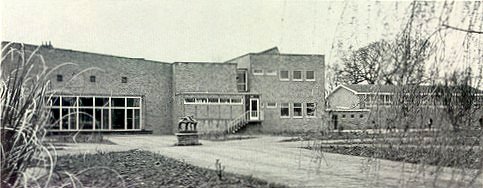
THE NEW BUILDINGS: Assembly Hall
(1957) and to the right, the Gymnasium (1963) |
The official opening
was performed fittingly by Mr. Bacon himself on 4th
October, 1957, with a dedication by the Archdeacon of
Ely, the Ven. H. F. Kirkpatrick. |
| Fourteen
months later Mr. Bacon was dead. The Headmaster wrote
of the school's profound shock and deep sorrow: "Few schools can ever have been so
fortunate in their Chairman of Governors as was this
school. His frequent visits to the school were both
stimulating and inspiring: stimulating because he was
enthusiastic in his praise ... and inspiring because
his pride in us was infectious . . . service without
thought of thanks ... that is his last impression to
those, boys and staff, who are left to carry on this
tradition."
|
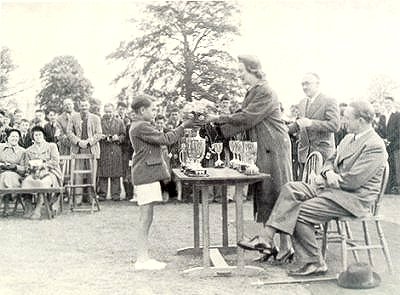
SPORTS DAY 1952
Mrs Bacon, in company with Mr BM Bacon, Chairman of
the Governors 1953-59, receives the traditional
bouquet. |
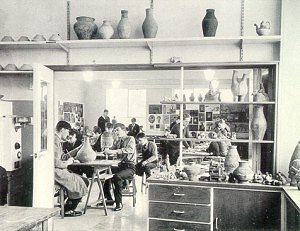
THE NEW ART STUDIO (February 1966)
[sic]
please click image for a larger version and key |
The school's growth
was not stemmed. By 1959 the school passed the 400
mark: further building was required. New plans were prepared: large inconvenience
was suffered.
Then in January 1963 Phase I was
completed giving a new gymnasium, an art room and a
biology laboratory as well as two classrooms, and -
not least in importance - a new staff-room.
|
Phase II involved a
reconstruction within the old building to combine the
headmaster's former study with the library to make proper
accommodation for an ever increasing number of books. An
appreciation of literature and a love of books must be one of
the greatest legacies that a school such as ours can bestow.
Soham's fine library looking onto the lawns is a truly
beautiful setting which can only enhance the learning
process. If one excludes the cities of Cambridge and Ely,
grace of landscape is not a noted characteristic of the
Fenlands from which the Grammar School has drawn so many of
its pupils. The fine agricultural soils are too valuable to
include much ornamentation.
The Fens, too, have preserved longer than
most areas of England a discernible identity. In some ways
valuable, this has given rise to a somewhat narrow vision.
The general broadening of horizons has hence been a more
important task at Soham than in some comparable schools, even
other rural schools. Travel, broadening the mind, has
featured largely in educational activities beyond the
classroom. The visit to Bruges at Easter 1953, the first
major foreign venture after the war, began a close
association with Belgium that lasted several years.
Latterly Austria, Italy and Switzerland
have been favoured. Recent winter skiing holidays certainly
point the changed economic circumstances of the area, since
government support of agriculture became permanent. Where
only 40 years ago the agricultural worker's basic wage was
28s. per week, the winter holiday symbol of wealth has become
a possibility. It was in 1954 that a further incentive to
travel came to Soham boys through the Mowforth bequest. Given
in memory of the Revd. William Case Morris, a Soham Old Boy, for social education, it
commemorated his work as a missionary for children in the
Argentine. The bequest has been used especially to foster
enterprising private trips in Britain or abroad. The Arctic
Circle, the Iron Curtain and Mount Vesuvius are some of the
remote places to see Soham's Morris Travel Scholars.
Day excursions are common to any
well-balanced school curriculum but none can have been more
enterprising that the 1972 trip to the Tutenkhamen Exhibition
at the British Museum, involving the whole school.
While
Geographical and Biological field study trips have
ranged far and near, both the Scouts and the A.C.F.
(founded in 1962) have introduced their members to
different types of camping.
These organisations are two of the most important
"out of school" activities. They cater for
different types of boy, teaching co-operation with
fellows.
They are always valuable: if they had outstanding
years perhaps they were 1964 when 15 of a Senior
Scout troop of 28 were Queen's Scouts and 1965 when
the A.C.F. won the Bishop of Ely shield for the best
County Unit, the Robinson County trophy for shooting
and the Eastern Command Cup for football - proof of
the value of their new hut and shooting range. |
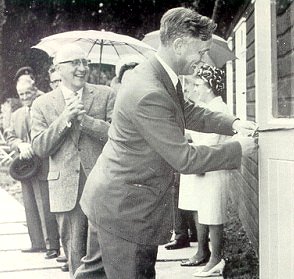
The opening of the Scout Hut (1968)
L-R: Alderman FH Jeeps (Chairman of the Governors),
Edward Armitage, Mr JW Rennison (Tewkesbury, formerly
i/c Scouting) |
The major extra-curricular activity has for
long been the School Play. A superb standard was established
as a result of House drama. A tradition of Gilbert and
Sullivan in the fifties gave way to traditional Shakespeare,
which has the advantage to schools that the author waives his
licence fee.
The latest plays saw great variety with
Anoujlh, Bolt, Wilde and Shaw all represented. A practice,
revived in 1967 after a lapse of 12 years, of inviting Ely
High School girls to collaborate, has been reversed too with
the appearance of Grammar School boys in Ely productions.
Musical activities have varied, with the choir during the
late 60s reaching national fame broadcasting on T.V. and
carrying out many local engagements under Mr. D. Riley's
baton.
Chess, which last flourished during the
war, has reached hitherto unknown heights under Mr, Hart's
guidance. The 1971 record was quite remarkable.
| The school's first
team were Regional Champions in the Sunday Times Cup,
going on to reach the last sixteen in the national
rounds, the second team reached the regional
semi-final in the same competition. The school also
won the Bedford Chess Festival, the Starr Cup for the
third time (thus winning it outright but returning it
for perpetual competition), the second division of
the Starr Cup, the second division of the Cambridge
and District Chess League (a 6th form team that), the
Taylor Cup for the best individual performance in the
County Schools League, and in the County Junior
Championships Ist and 2nd at Under 15 level and 1, 2,
3, 4 and 5 among Under 13s. |
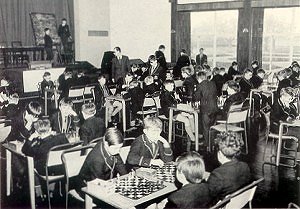
A 40 board match v Manor School Cambridge in 1967: Mr
Hart can just be seen near the piano. Note the layout
on stage for assemblies in the 1960s. |
Certainly an incomparable performance in
East Anglia, nor was this achieved by an exclusive selection
policy for 90 boys played in the 77 matches.
The variation of activities over a period
reflects the different interests and abilities of staff: as
masters come and go specialities change. As the 'Big Five' of
the thirties and forties began to retire others came to
establish themselves permanently at Soham.
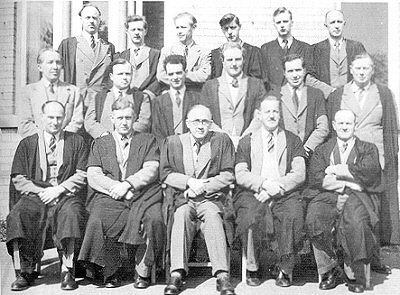
ACADEMIC STAFF 1953-54
ACV Foster - CR Waller - KD
Drake - G Phythian - L Kitchen - EH Tabraham
FK Webb - AF Pusey - E Quinn - AE Lawrance - RN Joiner - SR
Saunders
RA Taylor - TL Riley - E Armitage - CJ Ford - RL Thomas
Mr. S. Saunders arriving in 1947 stayed for
19 years till his retirement. Mr. E. H. Tabraham came in 1948
to teach Handicraft and ultimately to succeed Mr. T. L. Riley
as deputy headmaster. Mr. Taylor returned in 1948 from
Canada. In 1952 Mr. A. E. Lawrance came as Head of
Mathematics and remained for 12 years [he returned to Soham
in the 1970s as Warden of the Village College - editor]; in
1954 Mr. P. J. Askem to teach Art and spin an aesthetic web;
Mr. L. R. Hart in 1959 to teach French and that same year Mr.
R. G. S. Bozeat to take over Woodwork and bowl fast; in 1960
Mr. P. D. Scott, a mathematician with musical and electronic
connections; and in 1961 Mr. R. J. H. Makin for science but
also to become school engineer. These and others with shorter
but valuable service were to maintain and even increase the
academic standing of Soham Grammar School as the Head's
message of 1946 had hoped.
With the school growing in numbers old
organisation was no longer sufficient. The larger number of
pupils gave rise to a larger number of staff who could offer
specialist education in a wider range of subjects. Streaming
ceased in 1963 to be replaced by an option scheme involving a
variable and complex timetable. To maintain the prime
advantage of a small school that no-one becomes anonymous or
forgotten various means were used. The major change was the
creation in 1967 of the Junior School, consisting of First
and Second Forms with Mr. Taylor appointed to be responsible
for these formative years.
Simultaneously the Sixth Form was regrouped
into smaller tutorial groups. This had been preceded by the
splitting of Speech Day in 1965 into Senior and Junior and in
1966 into Senior, Middle and Junior. These were to be
replaced in 1969 by Open Days - one for each year, much less
formal and giving scope for contributions from every boy.
In different spheres Soham kept abreast of
reform. Platt Prizes instituted in 1961 by the will of the
former headmaster were awarded, on the choice of the boys
themselves, one prize for each year. Nuffield Science courses
were begun, the school being one of the pioneers of the
Physics project from 1963. Careers advice came to play a
greater part in the senior school, with Fifth formers having
careers periods and a biennial Careers Convention being
established in 1969. Even the imminent reorganisation of
secondary education did not deter: in 1971 a computer link
was established with the Cambridge College of Technology.
This diversification was not allowed to
interfere with the standard of academic work. Indeed the
post-war years under Mr. Armitage were undoubtedly the years
of highest academic achievement. No longer was Soham a rural
grammar school, rather a traditional grammar school in a
rural setting.
Between 1946 and 1962, when they were
abolished, State Scholarships were won in eleven years and
reserve places in a further two. On two occasions three State
Scholarships were won (1951 and 1962). In 1964 three boys
entered Cambridge University on scholarships - J. M. Daly
taking the Trevelyan Scholarship at Pembroke - while a fourth
won an engineering scholarship to Bristol. 1965 saw an
improvement. An open exhibition in science at Lincoln
College, Oxford, for G. Allen, obtained when only 16.1 years
was a prelude to his winning the Cambridge Examinations
Syndicate prize for the highest marks in Physics and
Chemistry. An Atomic Energy Authority Scholarship tenable at
Cambridge fell to A. W. Pennick; two Coal Board scholarships
at Newcastle were won; and a textile chemistry award at
Manchester. In 1970, one pupil went to Cambridge and three to
Oxford, with S. G. Melton gaining a Minor Scholarship in
History at Wadham College.
So right up to the Comprehensive
reorganisation of September 1972, which involved its
amalgamation with the neighbouring Village College and the
transference of the Sixth Form to Ely, has Soham fulfilled
the ideal of a grammar school, setting a standard of
excellence as its goal in every field. As three pupils wrote
in 1955:
"Education should
fit a boy for life and cater for all his needs. The fact that
this
was realised and put into practice as far as possible at
Soham must surely
be taken into account when we attempt to account for its
successes".
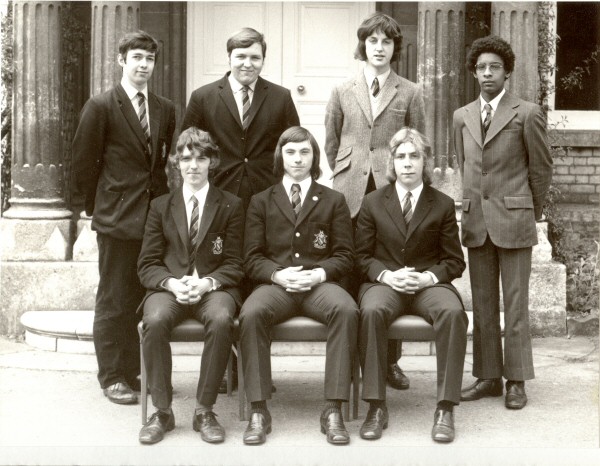
PRIZEWINNERS 1972
back: SC Wynn
(Headmaster's), D Crabb (Parents' Association),
SL Murfitt (Old Boys), PA Bolton (Parents' Association)
front: SB Thornhill (Stubbs Cup), B King (Bacon Cup), SJ
Yeomans (Headmaster's)
Guest of honour at the 1963 Speech Day was
Mr. F. L. Allen, Secretary of the Headmasters' Association,
who in a letter afterwards commented:
"it seems to me
typical of your school that there was an air of concentrated
personal
attention on the part of everyone assembled in the hall. It
was a family affair on a large
scale with the mood heightened by the colour and excitement
of a special day".
Typical too that despite the natural
sadness that a school was disappearing, a recent old boy
could write:
"I must admit that
any feelings of nostalgia I might have had for the school
in its present form are overriden by the conviction that the
reorganisation
is a forward movement in the educational facilities of the
Isle of Ely".
In such objectivity mingled with tradition
lies the essential spirit of Soham Grammar School, 1686-1972.
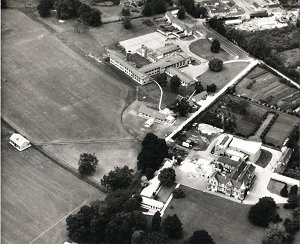
Soham Grammar School & Village College, 1961
click on the image for a larger version |
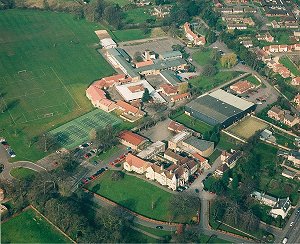
Soham Village College 2001
click on the image for a larger version |
Aerial views
courtesy of Chris Scurrah, SVC webmaster
last updated 24 Dec 10
 Mr. Crouch was
also an acting Pilot Officer and by the end of the
war over 200 cadets had passed through the unit.
Mr. Crouch was
also an acting Pilot Officer and by the end of the
war over 200 cadets had passed through the unit. 










